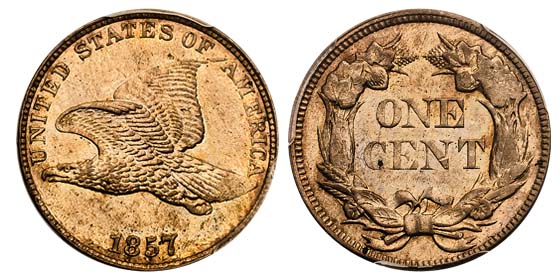Flying Eagle Penny Values
How Much Flying Eagle Pennies are Worth: Flying Eagle Penny Values & Coin Price Chart

Year | Mint | Variety | Designation | VG-8 | F-12 | VF-20 | EF-40 | AU-50 | U-60 | MS-63 | MS-64 | MS-65 | MS-66 | MS-67 |
|---|---|---|---|---|---|---|---|---|---|---|---|---|---|---|
1800 | P | Plain 4- Stemless Wreath | Red-brown | 200 | 300 | 400 | 500 | 600 | 700 | 800 | 900 | 1000 | 1200 | 1100 |
| Year | Mint | Variety | Designation | VG-8 | F-12 | VF-20 | EF-40 | AU-50 | MS-60 | MS-63 | MS-64 | MS-65 | MS-66 |
|---|---|---|---|---|---|---|---|---|---|---|---|---|---|
| 1856 | (None) Phil | -- | -- | $8,045 | $10,135 | $11,363 | $12,663 | $13,725 | $16,425 | $24,750 | $34,450 | $68,875 | $167,500 |
| 1857 | (None) Phil | -- | -- | $42 | $100 | $180 | $182 | $306 | $610 | $1,073 | $1,670 | $3,560 | $10,790 |
| 1858 | (None) Phil | Large Letters | -- | $90 | $48 | $200 | $270 | $360 | $597 | $1,148 | $1,780 | $3,760 | $8,300 |
| 1858/7 | (None) Phil | Strong | -- | $183 | $287 | $400 | $795 | $1,515 | $3,995 | $9,880 | $33,495 | $57,300 | -- |
| 1858/(7) | (None) Phil | Weak | -- | $75 | $131 | $162 | $287 | $407 | $665 | $1,221 | $1,847 | $3,872 | -- |
| 1858 | (None) Phil | Small Letters | -- | $60 | $85 | $100 | $162 | $301 | $655 | $1,294 | $2,069 | $4,065 | $19,995 |
Description and History
The Flying Eagle penny lasted for only two short years as a circulating coin, but its influence on U.S. coinage is significant. It’s a highly collectible coin that marked a shift in philosophy for the U.S. Mint and a change in America’s relationship with its own coins.
Before the Flying Eagle cent, cents were larger, and they often circulated next to coinage from other countries that were used for small purchases as legal tender the same way American cents were. That began to change around the time this cent was minted.

